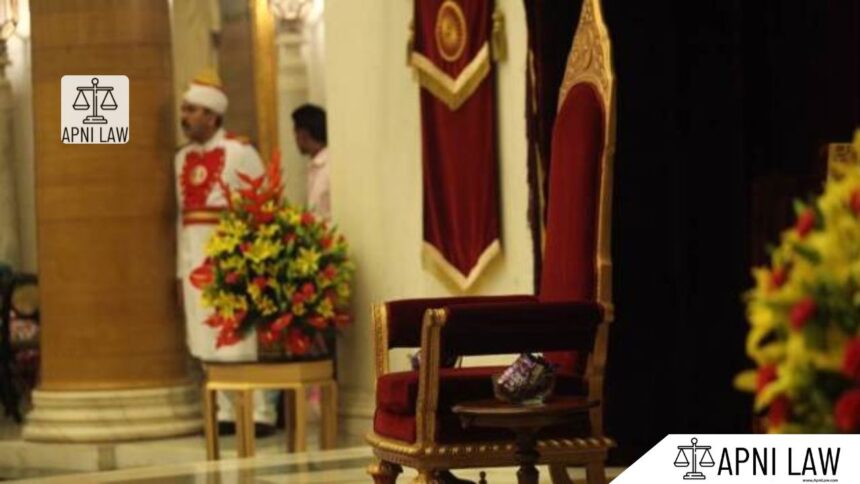Introduction
The Constitution of India establishes the offices of the President and the Vice-President as two of the highest positions in the Republic. Both offices serve different roles, powers, and responsibilities in the governance of the nation. While the President stands as the head of state, the Vice-President mainly performs legislative duties and steps in as acting President when necessary. Understanding the distinctions between these two offices is crucial to appreciating India’s democratic framework.
Who Is the President of India?
The President of India is the supreme constitutional authority and the head of state. Articles 52 to 62 of the Indian Constitution define the President’s position, powers, and responsibilities. The President symbolizes the unity of the nation and represents India in domestic and international affairs.
The President exercises executive powers through the Union Council of Ministers, headed by the Prime Minister. Although many powers are exercised on ministerial advice, the President holds significant constitutional responsibilities such as summoning Parliament, assenting to bills, promulgating ordinances, and safeguarding the Constitution during emergencies.
Who Is the Vice-President of India?
The Vice-President is the second-highest constitutional office in India. Articles 63 to 71 of the Constitution describe the Vice-President’s role, election, and functions. The Vice-President primarily acts as the ex-officio Chairman of the Rajya Sabha, India’s upper house of Parliament.
Unlike the President, the Vice-President does not hold executive powers. The role is more legislative in nature, focused on conducting parliamentary proceedings, ensuring discipline in the Rajya Sabha, and casting a deciding vote in case of a tie. However, the Vice-President assumes the office of Acting President during vacancies caused by death, resignation, or removal of the President, ensuring continuity of governance.
How Are the President and Vice-President Elected?
The election processes for both offices differ significantly. The President is elected by an Electoral College comprising elected Members of Parliament and elected members of the Legislative Assemblies of states and Union Territories. This method ensures federal representation and balance between the Union and the states.
The Vice-President, on the other hand, is elected solely by Members of Parliament from both the Lok Sabha and Rajya Sabha, including nominated members. This election uses a system of proportional representation through a single transferable vote. The difference highlights the broader representative role of the President and the legislative focus of the Vice-President.
What Is the Tenure of the President and Vice-President?
Both offices carry a tenure of five years. The President can seek re-election for multiple terms. India has already witnessed re-elections, such as Dr. Rajendra Prasad, who served as the first President for two consecutive terms.
The Vice-President also serves for five years, with the possibility of re-election. Several Vice-Presidents, such as Dr. Sarvepalli Radhakrishnan and Hamid Ansari, served multiple terms, demonstrating the continuity of leadership in this office.
What Happens During Succession and Vacancy?
If the office of the President falls vacant due to death, resignation, or removal, the Vice-President immediately assumes the role of Acting President. This arrangement continues until a new President is elected within six months. During this period, the Vice-President ceases to perform duties as the Chairman of the Rajya Sabha.
In contrast, when the Vice-President’s office falls vacant, a fresh election is conducted as soon as possible. The President does not assume any role in such a case. This difference highlights the President’s centrality in governance and the Vice-President’s supportive role.
How Can the President and Vice-President Be Removed?
The removal procedures for both offices are also distinct. The President can only be removed through the complex process of impeachment. Parliament can initiate impeachment if the President violates the Constitution. The process requires a two-thirds majority in both Houses, making it deliberately difficult to preserve the dignity and stability of the office.
The Vice-President, however, can be removed by a resolution of the Rajya Sabha, passed by an absolute majority, and agreed to by the Lok Sabha. A 14-day notice is required before moving such a resolution. This process is relatively simpler than impeachment, reflecting the Vice-President’s primarily legislative role.
What Are the Powers of the President?
The President of India holds executive, legislative, and emergency powers. As the supreme commander of the armed forces, the President safeguards national security. The President appoints key officials, including the Prime Minister, Governors, Supreme Court and High Court judges, and Election Commissioners.
Legislatively, the President summons Parliament, dissolves the Lok Sabha, and gives assent to bills. Without the President’s approval, no bill can become law. The President also promulgates ordinances when Parliament is not in session.
During national emergencies, financial emergencies, or President’s Rule in states, the President’s powers expand significantly. In such situations, the President acts on the advice of the Union Cabinet but plays a decisive constitutional role in maintaining governance.
What Are the Powers of the Vice-President?
The Vice-President’s powers are limited and largely legislative. The Vice-President serves as the ex-officio Chairman of the Rajya Sabha, ensuring orderly conduct and discipline in parliamentary debates. When the House faces a deadlock, the Vice-President casts the deciding vote.
The Vice-President also represents the Rajya Sabha in various capacities, ensuring coordination between the executive and the legislature. Beyond this, the Vice-President has no direct executive authority, except when serving as Acting President.
How Do Their Roles Differ in Practice?
The President functions as the constitutional head of state, while the Prime Minister and Council of Ministers run the government. This position carries symbolic, diplomatic, and constitutional authority. For instance, the President represents India during foreign visits and signs international treaties.
The Vice-President operates within the legislature, maintaining neutrality and discipline in the Rajya Sabha. The office ensures smooth functioning of parliamentary democracy. In practice, while the President represents India’s sovereignty, the Vice-President safeguards parliamentary traditions.
Why Is the President’s Role More Powerful?
The President commands the armed forces, approves bills, and exercises powers during emergencies. The office influences governance, administration, and national security. Though the President usually acts on the advice of ministers, the constitutional role ensures balance and checks on the executive.
By contrast, the Vice-President lacks executive authority. The powers are confined to parliamentary procedures and succession duties. This distinction ensures that while the President symbolizes state power, the Vice-President focuses on legislative functioning.
How Do These Differences Affect Governance?
The differences between the President and Vice-President reflect the principle of separation of powers. The President ensures national unity, stability, and constitutional governance. The Vice-President secures parliamentary discipline and continuity during emergencies.
Together, they create a system of balance. The President upholds constitutional sovereignty, while the Vice-President strengthens parliamentary democracy. These distinctions highlight India’s unique federal and democratic design.
For any specific query call at +91 – 8569843472
Conclusion
The President and the Vice-President of India hold distinct constitutional offices with different roles and powers. The President stands as the head of state, exercising executive, legislative, and emergency powers. The Vice-President functions as the Chairman of the Rajya Sabha and assumes the President’s role during vacancies.
Their election, tenure, removal procedures, and powers differ to maintain balance within India’s democratic framework. The President symbolizes the sovereignty of the nation, while the Vice-President ensures legislative continuity. Both offices together protect the spirit of the Constitution and ensure smooth governance.








